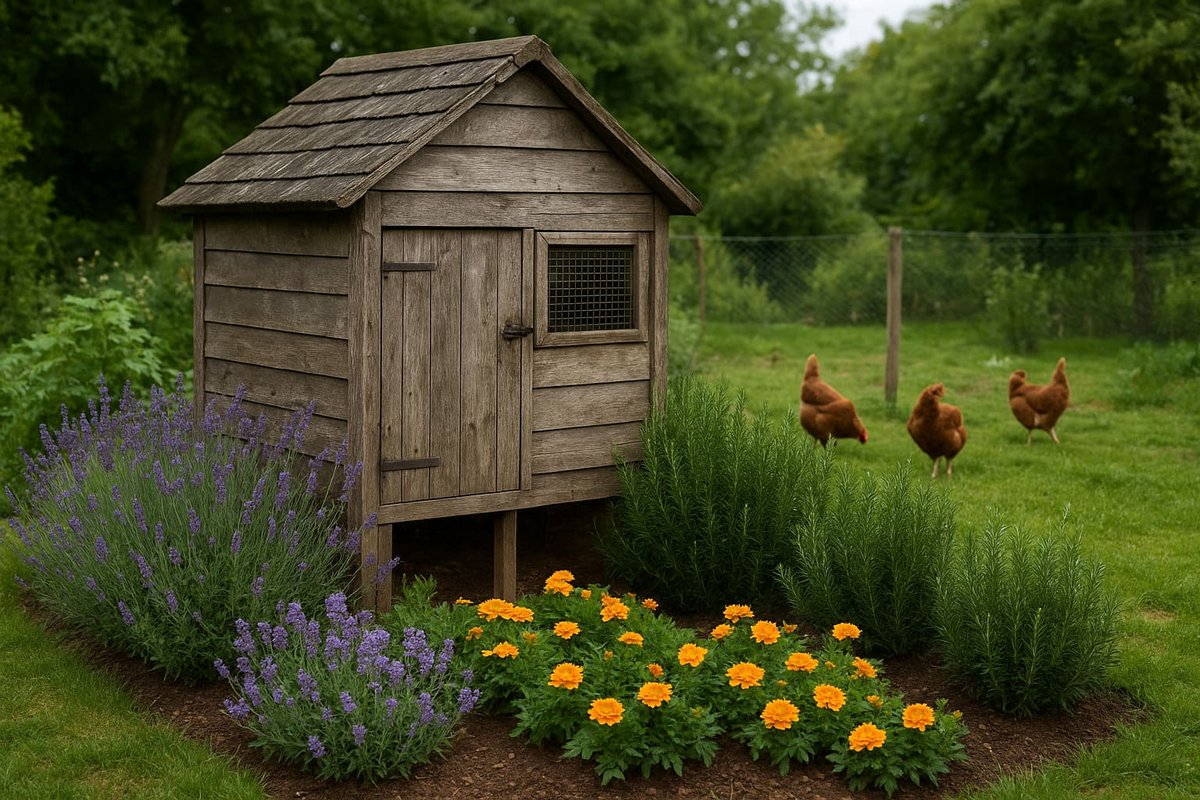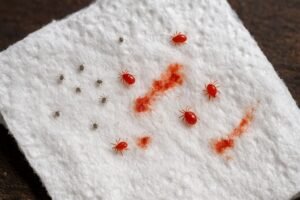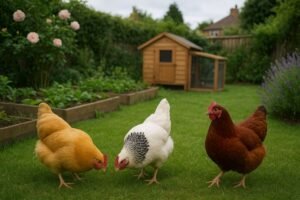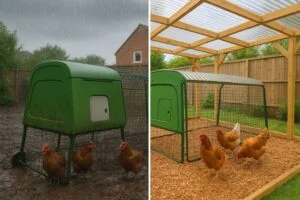If you’re a backyard chicken owner in the UK wondering about the best plants to grow around your coop to deter pests, you’re in exactly the right place. Let’s be honest, keeping chickens in a small garden—whether you’re in a damp part of Scotland or a terraced house in London—comes with challenges. For a full overview, see our guide on keeping chickens in the UK. Our lovely wet weather can mean mud, and mud can mean pests. A covered run to keep your flock dry in the rain can be a lifesaver. Keeping your coop clean and your hens happy is priority number one, and pests like rats, mice, and mites are a constant battle. While this guide tackles pests, predator-proofing your chicken coop is another vital step.
So, how do you fix it? You’ve probably heard about “biosecurity” (which is just a fancy word for keeping diseases and pests away from your flock). A massive part of this is keeping wild rodents and bugs out. While traps and secure feed bins are essential, nature has given us a brilliant, helping hand: plants.
I’m a UK chicken keeper myself, and for years I struggled with mice trying to sneak into my feed shed. In my garden near Manchester, the damp ground seemed to attract them. But then I planted a huge border of mint and lavender, and it genuinely made a difference. It’s not a magic forcefield, but it’s a powerful, natural way to make your coop a less attractive place for pests to visit.
In this guide, we’re going to walk through everything you need to know. We’ll cover the best plants around chicken coop areas for UK weather, focusing on options that are safe for your hens. We’ll explore exactly what plants keep rats away from chicken coops and why you should put marigolds in your chicken coop.
This is all about practical, natural pest control for backyard chickens in the UK. These are UK-hardy plants, safe for your hens (and often edible!), that follow the spirit of guidelines from bodies like DEFRA and the British Hen Welfare Trust (BHWT). We’ll cover:
- A top-10 list of the best pest-repelling plants.
- Which plants are best for rats, mice, and bugs.
- What’s safe for your hens to nibble on (and what they’ll ignore).
- A step-by-step guide on how to plant them.
Ready to build a natural fortress for your flock? Let’s dig in.
The Best Plants to Grow Around Your Coop to Deter Pests in the UK
First up, the big list. When you’re deciding what to put around a chicken coop, you want plants that work hard. This means they either smell too strong for pests, are safe for chickens, or even help the health of your flock. These plants fall into three main groups:
- Deterrents: These have strong oils and smells that pests (especially rodents and insects) hate. This is your first line of defence.
- ‘Trap Crops’: These plants, like nasturtiums, are more attractive to certain pests (like aphids) than your coop or your hens. The pests attack the plant and leave your chickens alone.
- Health Boosters: These are herbs that are safe and healthy for your chickens to eat, helping to boost their immune systems from the inside out.
Here are my top choices for UK gardens. They are all UK hardy plants for poultry runs that can handle our weather and will help create a bug-free (or at least, bug-reduced!) coop setup.
Top Pest-Deterrent Plants for UK Coops
| Plant | Why It Helps Deter Pests | Safe for Chickens? | UK Growing Tips |
|---|---|---|---|
| Mint (Peppermint) | The strong scent is hated by rodents. This is a top rodent proof chicken run idea. | Yes. Chickens will mostly ignore it, but it’s safe if they nibble. | Warning: Plant in deep pots! It spreads like wildfire in damp UK soil. |
| Lavender | Rodents and many insects (including mites, reportedly) dislike the smell. It’s also calming for hens. | Yes. It’s one of the perennial plants for chickens they can safely peck. | Loves sun, but is very hardy. Choose an English Lavender variety (‘Hidcote’ is great) for the best results in the UK. |
| Marigolds (French) | The scent repels masses of flying insects and nematodes (tiny soil bugs). | Yes! Hens often eat the petals, which can make their yolks a deeper orange. | Very easy to grow from seed in spring. They love sun and will flower all summer long. |
| Rosemary | A tough, woody herb with a strong pine-like scent that deters many bugs and rodents. | Yes. It’s a tough plant, so they’re unlikely to eat much, but it’s perfectly safe. | Needs sunny, well-drained soil. A great perennial plant for chickens. |
| Sage | Another strong-smelling herb that rodents and bugs tend to avoid. | Yes. It’s safe and has health benefits. It’s one of the top three plants rats hate. | Very hardy. A brilliant, low-maintenance herb for your herb garden for chicken coop. |
| Nasturtium | A fantastic “trap crop.” It attracts aphids, pulling them away from your coop. | Yes! The entire plant is edible for hens and humans. A great health-booster. | Incredibly easy to grow from seed. They are quick-growing plants for chickens and can climb. |
| Thyme (Lemon) | Strong-scented. It’s a good ground-cover plant that repels insects. | Yes. A fantastic, safe, and edible herb for safe hens. | Hardy and low-growing. Likes sun and doesn’t mind poorer soil. |
| Oregano | The pungent oil in the leaves is a known insect repellent. | Yes. One of the best plants to grow for chickens to eat, as it has natural antibiotic properties. | Easy to grow and will come back every year. Spreads gently. |
| Garlic Chives | The strong onion/garlic smell is a great deterrent for rodents and insects. | Yes, in small amounts. Chickens tend to avoid the strong flavour. | Very hardy perennial. Will pop up every spring without any fuss. |
The ‘Advanced’ Deterrents (Use With Caution)
You might read about other, more powerful-smelling plants. These are fantastic deterrents but must be used carefully, as they can be toxic if eaten in large quantities.
- Wormwood (Artemisia): This plant is famous for its bitter smell and is a brilliant insect and rodent deterrent. However, it can be toxic to chickens if they eat a lot of it.
- Tansy: Another old-fashioned insect-repelling plant, especially good against flies and ants. Like wormwood, it’s not one for the hens to gorge on.
The Rule: Plant these “advanced” options outside the chicken run, where the hens can’t freely eat them. Plant them as a border around the perimeter fence to create a powerful-smelling barrier that pests won’t want to cross.
Creating a border of smelly plants is your first big step. Now, let’s focus on the biggest problem for most UK keepers: rats and mice.
What Plants Keep Rats Away from Chicken Coops?
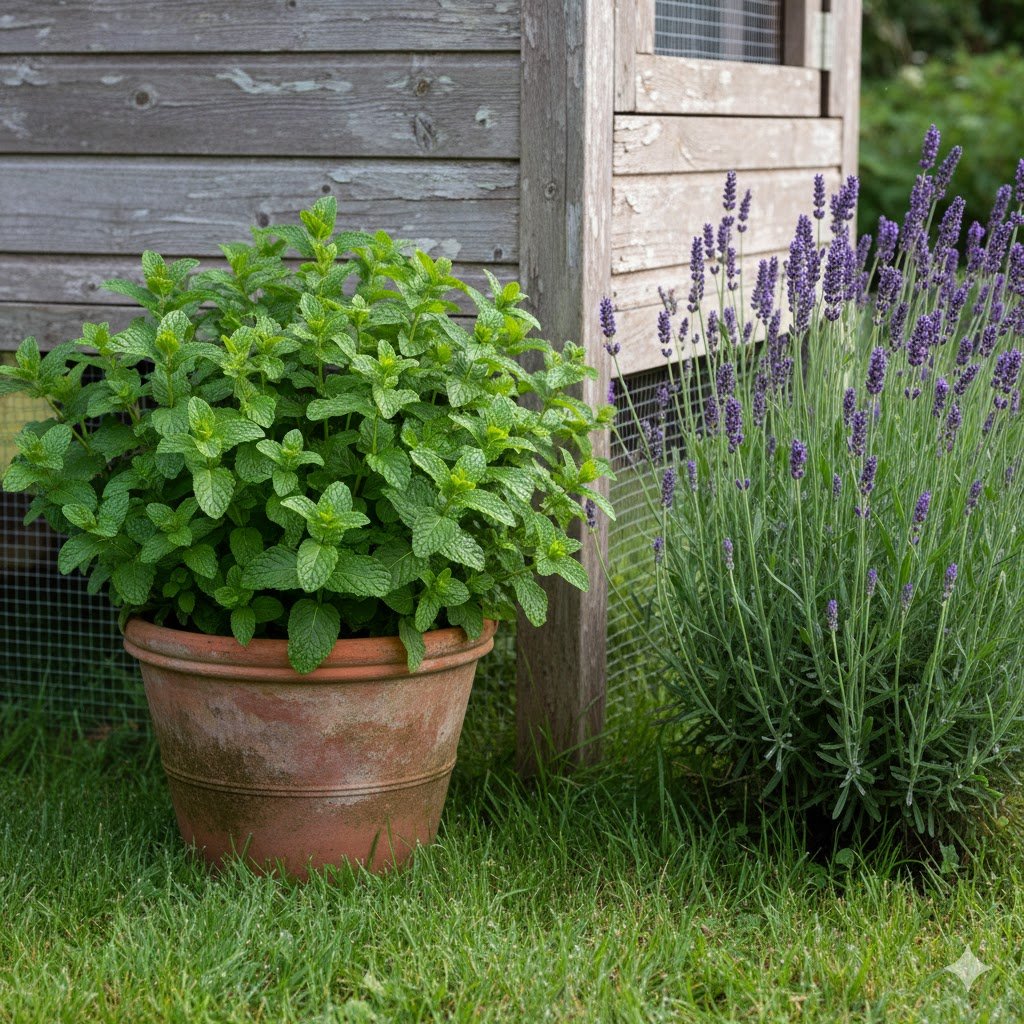
This is the big one, isn’t it? If you’re asking “what’s the number one pest I need to worry about,” it’s rats. Rats and mice are the number one enemy for most backyard chicken keepers. They’re drawn by spilt food and warm, dry coops. For a complete strategy, read our full guide on how to keep rats out of your chicken coop. The key is to make the area around your coop as unwelcoming as possible, and scent is your best weapon.
How Scent Confusion Works
Rats and mice have terrible eyesight but an incredible sense of smell. They use it to find food and follow paths. Strong-smelling plants act like a “scent-bomb.” The powerful oils in plants like mint and lavender get on their paws and fur, irritating their sensitive nasal passages and, more importantly, masking the delicious smell of chicken feed. If they can’t easily smell the food, they are much more likely to move on to an easier target.
Your Top 3 Rodent-Repelling Plants
If you do nothing else, plant these three.
- Mint (especially Peppermint): This is the king of rodent repellents. The smell is overwhelmingly strong to a rat. This is why you’ll hear it mentioned in all sorts of natural pest control tips.
- Lavender: That lovely, calming smell we enjoy? Rodents hate it. It’s a fantastic choice for planting in a border around the coop or near any entrance points.
- Sage: Another powerful, pungent herb. It’s woody and hardy, making it a great low-maintenance barrier.
A quick note: What three plants do rats hate? If you ask any seasoned gardener, they’ll almost always say Mint, Lavender, and Sage. They are the holy trinity of natural rodent-repellent plants.
Other Rodent-Repelling Plants to Add
- Rosemary: The woody, pine-like smell is another one rodents tend to avoid.
- Garlic & Garlic Chives: The strong sulphuric smell is unpleasant for them.
- Wormwood: As mentioned above, this is a powerful deterrent, but plant it on the outside of your run.
Beyond Planting: Using Scent to Your Advantage
Don’t just rely on living plants. You can boost your defences:
- Peppermint Oil: You might hear questions like, “How do the Amish get rid of mice?” They famously use peppermint plants and oil. Soak cotton balls in 100% peppermint essential oil (you can get it online) and place them in a jar with holes punched in the lid. Put this inside your feed shed or under the coop (where hens can’t get to it). You’ll need to refresh it weekly.
- Dried Herbs: Hang bunches of dried lavender, mint, and rosemary inside your coop and in the nesting boxes. It’ll smell lovely to you, act as a deterrent, and even help calm your hens.
Of course, repelling rats is only half the battle. You also need to make sure that anything you plant is 100% safe for your curious flock.
What Plants Are Safe Around Chicken Coops?
This is just as important. A common question I get from new keepers is, “I’ve planted mint, but will my chickens eat it and get sick?” The last thing you want is to plant something that could harm your flock. The good news is that most common herbs and flowers are perfectly safe.
All the plants listed in the main table above—Mint, Lavender, Marigolds, Rosemary, Sage, Nasturtium, Thyme, Oregano, and Garlic Chives—are safe plants around chicken coops. Chickens are pretty smart; they tend to avoid plants that are bad for them or that taste too strong. For a more exhaustive list, this chicken-friendly plants guide from PoultryKeeper is an excellent UK-based resource.
However, many common UK garden plants are surprisingly toxic.
The “Do Not Plant” List: Plants Toxic to Chickens
It’s vital to know what not to plant. Many common garden plants can be deadly to chickens, even in small doses. Keep these well away from your run and any areas they might forage.
- Nightshade Family: This includes the leaves and green parts of potatoes, tomatoes, and aubergines. The ripe fruits are fine, but the plants themselves contain solanine.
- Rhubarb Leaves: Highly toxic due to the oxalic acid (for us, too!).
- Foxglove: A beautiful, common UK flower, but highly toxic to the heart.
- Daffodil and Tulip Bulbs: All parts, but especially the bulbs, are very toxic.
- Azalea and Rhododendron: All parts are toxic and can cause severe illness or death.
- Yew: Extremely toxic. Even a few needles can be fatal.
- Lobelia: A common bedding plant, but toxic.
- Oak: The acorns and young leaves are toxic in large quantities (tannic acid).
This is by no means a complete list. For a comprehensive resource, I strongly recommend checking this list of poisonous plants for chickens from the BHWT before planting anything new.
When in doubt, always check with a reliable source like the BHWT before planting something new. If you must have these plants, make sure they are in a completely separate, fenced-off part of your garden.
Knowing what’s safe is one thing, but what will your hens actually eat, and what will they leave alone? This helps you decide where to plant them.
What Plants Will Chickens Not Eat? (And What Will They Eat?)
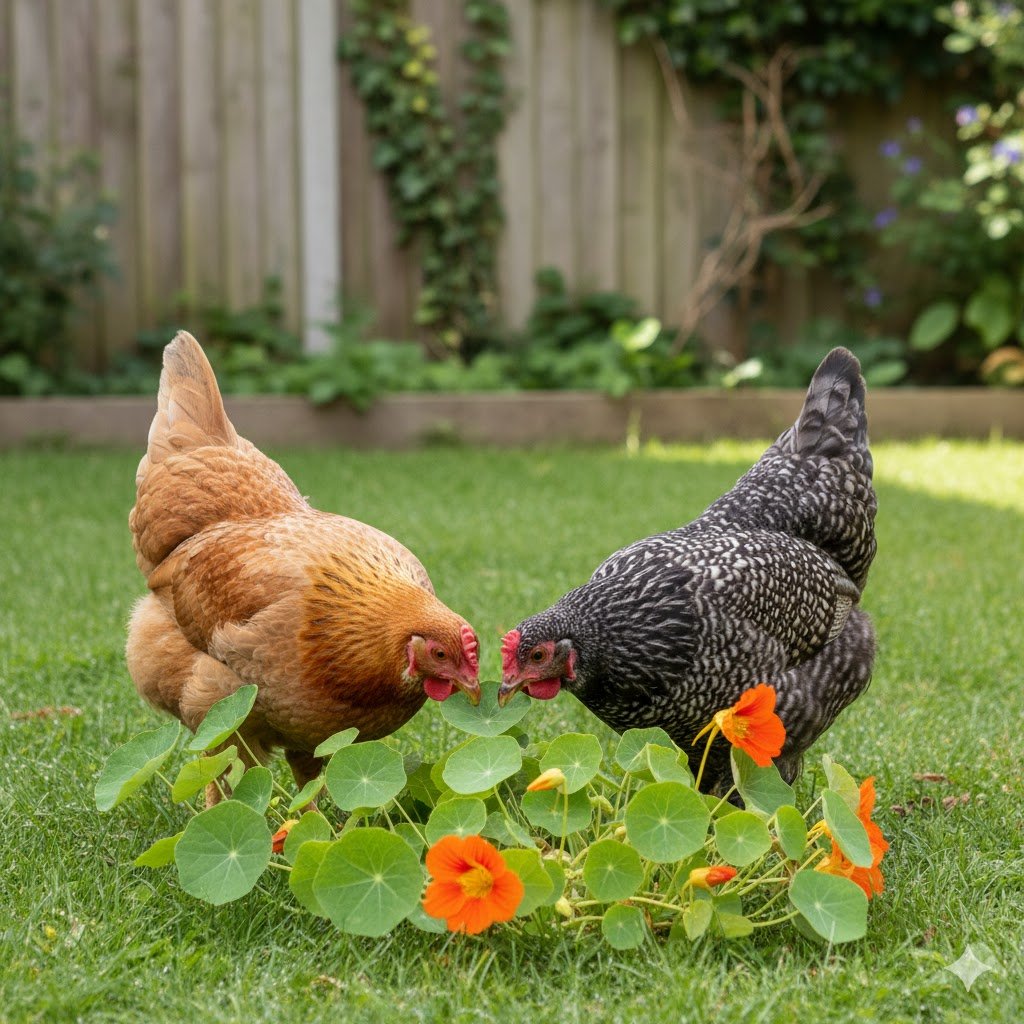
This is a great question. You’re planting these to deter pests, not to provide a free-for-all salad bar for your hens! (Though… a little salad bar is a good thing!).
Plants Chickens Will (Mostly) Ignore
From what I’ve seen in my flock, chickens will avoid plants with very strong, pungent, or “soapy” smells, or plants that are tough and woody. This includes:
- Lavender
- Mint
- Rosemary
- Sage
- Wormwood & Tansy (They know to avoid these!)
They might have a curious peck, but they won’t destroy and devour them. This makes them the perfect pest repellent plants for poultry UK 2025 because they’ll last the season and do their job. You can plant these around the run without worrying they’ll be eaten to the ground.
The Chicken ‘Salad Bar’: Plants to Grow for Chickens to Eat
On the other hand, some plants are fantastic for your chickens to eat. They are great for “enrichment” (beating boredom) and how to encourage natural foraging in chickens, and are packed with vitamins and health-boosting properties.
- Nasturtium: This is the best one. They’ll eat the leaves and flowers. It’s a quick-growing plant for chickens—you can get flowers in as little as 30 days from seed. Many keepers believe it acts as a natural wormer and helps boost egg yolk colour.
- Oregano: A total superfood for hens. It’s believed to have natural antibiotic properties and helps support their immune systems.
- Thyme: Especially good for respiratory health. You can hang a bunch in the coop for them to peck at, or chop it up and add it to their feed.
- Marigolds: They love pecking the flower heads.
- Parsley: Packed with vitamins K, A, and C.
- Dandelions: Don’t pull them! These “weeds” are a free, nutritious treat for your flock.
The Rule: You can plant these “eating plants” inside the run, but be warned, they won’t last long! A better idea is to plant them on the outside and cut a few leaves and flowers as a treat each day, or grow them in a pot you can move in and out of the run. This all ties into the classic chicken run vs. free range pros & cons debate about balancing safety with natural behaviour.
Planting is a fantastic, natural step, but it’s only one piece of the pest-free puzzle. You can’t just plant some mint and hope the rats move out.
How Do I Keep My Chicken Coop Pest Free? (The Full Plan)
Planting is a brilliant step, but it’s part of a bigger plan. As any DEFRA guide on biosecurity will tell you, you need a multi-step approach. You can find everything you need in our complete UK chicken supplies checklist. This is especially true with recent updates, like DEFRA’s latest biosecurity measures for backyard poultry, which stress the importance of protecting flocks from disease and pests. Our poultry farm biosecurity plan covers this in depth. You cannot just plant herbs and walk away and expect a pest-free coop. This is about making your coop an unattractive, clean, and secure place. This starts with having one of the best fox-proof chicken coops in addition to using plants as a deterrent.
Here’s a simple how-to guide to a pest-free coop:
Step 1: The Fort Knox Feed Strategy (Non-Negotiable)
This is 80% of the battle. Rats and mice are there for the food. (Of course, using one of the best UK poultry feed brands helps ensure they clean it all up!).
- Metal Bins: Store all your feed in a metal (not plastic) bin with a secure, tight-fitting lid. Rats can and will chew straight through plastic.
- Sweep Up: Sweep up any spilt feed every single evening before dusk. Don’t leave anything on the ground overnight.
- Treadle Feeders: Invest in a treadle-feeder. These only open when a chicken (or something of that weight) stands on the platform, keeping rats and wild birds out. Investing in one of the best automatic chicken coop door options also secures the coop overnight.
- No Scraps Late: Don’t throw kitchen scraps into the run late in the afternoon. Give them treats in the morning that they can clean up well before bedtime.
Step 2: The ‘Deep Clean’ Biosecurity Routine
Pests love filth. Mites, in particular, thrive in damp, dirty coops.
- Daily: Do a quick “poo-pick” from the dropping boards.
- Weekly (The Red Mite Check): This is crucial. From what I’ve seen in my flock, this check is the single best way to catch an infestation early. Red mites live in the coop, not on the chicken (during the day). They hide in crevices and at the ends of perches. Once a week, lift out your perches and check the ends. If you see a grey, ash-like dust, those are mites.
- Monthly: A full clean-out. Scrape down all surfaces, replace all bedding. Choosing the best bedding for chickens in the UK is key for handling our damp weather.
- Twice a Year (The Deep Clean): A full scrub-down with a poultry-safe disinfectant (like Virkon S). Let it dry completely before putting in new bedding.
Step 3: Plant Your “Pest-Deterrent Barrier”
This is what we’re here for! Use the list in this guide to create a border of strong-smelling herbs around the perimeter of your coop and run. Focus on planting near doorways, under windows, and near your feed bin. Remember to leave that 1-2 foot gap!
Step 4: Managing Bugs, Mites, and Flies
- For Red Mite: If you find them, you must act fast. We have a detailed guide on getting rid of red mites in a wooden coop. A deep clean is essential. After cleaning, dust the entire coop (especially crevices and perch ends) with Diatomaceous Earth (DE). Using diatomaceous earth for chickens is a very common method. This is a natural, safe powder that kills mites by drying them out. You can find more details in PoultryKeeper’s red mite treatment and prevention tips. For a heavy infestation, always consult a poultry vet for professional treatment options.
- For Flies: Flies hate herbs like Mint, Lavender, and Basil. Planting these around the coop door helps. You can also use simple, non-toxic red-top fly traps placed away from the coop to draw them elsewhere.
- For ‘Bad’ Bugs: Encourage ‘good’ bugs! Marigolds and Nasturtiums attract beneficial insects like ladybirds, which will eat pests like aphids. These are all natural ways to keep parasites out of your coop.
What Plants Attract the Least Amount of Bugs?
That’s a great question, because nobody wants a swarm of insects right next to their coop. The best plants for this are actually the ones with strong, pungent, oily leaves.
- Herbs like Lavender, Rosemary, Mint, and Sage are fantastic. Most flying insects find their strong smells overpowering and will steer clear. They don’t have the sugary nectar that attracts wasps and swarms of flies.
- Marigolds are a bit of a special case. As we’ve covered, they repel bad bugs (like whitefly) but can attract good bugs (like ladybirds). This is a positive thing!
- Plants to AVOID if you’re worried about bugs are sugary, nectar-rich flowers (like buddleia or heavily-scented honeysuckle) planted right next to the coop. Keep those elsewhere in your garden.
You’ve got the full plan now: secure food, clean coop, and a plant barrier. Let’s look a little closer at the “star players” in your new coop garden.
Best Plant to Grow Around Your Coop to Deter Pests: Marigolds, Lavender, and Climbers
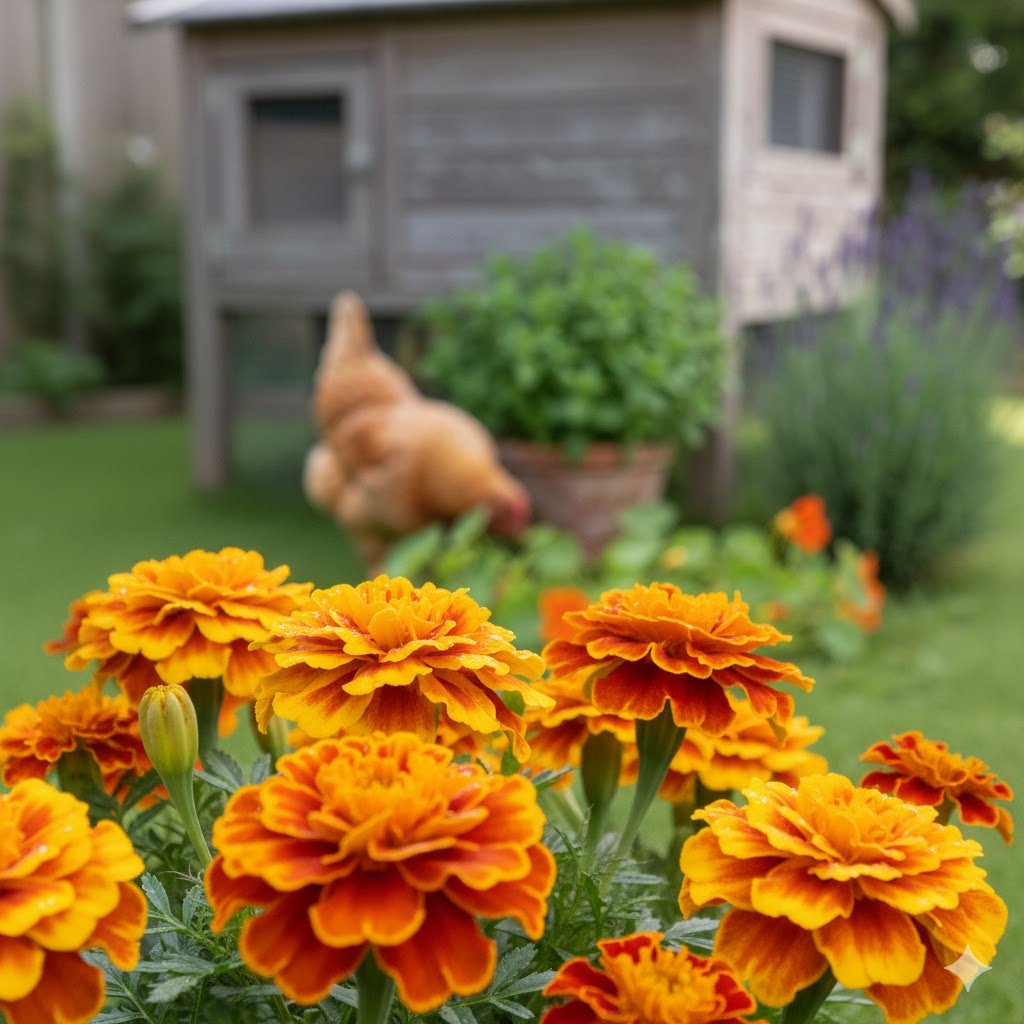
Let’s look a little closer at the most popular choices. If you’re wondering why everyone recommends marigolds, or if lavender is really worth it, this section is for you. These are the plants I get asked about most, and for good reason—they’re easy to grow in the UK and they work.
Why Put Marigolds in Your Chicken Coop?
I recommend marigolds to every single chicken keeper. They’re cheap, cheerful, and work hard.
- Bug Repellent: The scent (especially from French Marigolds) is famous for repelling whitefly, greenfly, and other annoying flying insects.
- Mite Deterrent: Many keepers (myself included) hang bunches of dried marigolds inside the coop and nesting boxes to help deter mites.
- Yolk Colour: When your hens eat the bright yellow and orange petals, the carotenoids (natural pigments) can help make their egg yolks a richer, deeper orange.
- Easy to Grow: They are one of the easiest, safest, and most bug-free coop setup for UK weather plants you can find. Just plant seeds after the last frost.
Will Chickens Eat Lavender?
Yes, they will, but usually only in small amounts. They’ll have a peck here and there. Will chickens eat lavender enough to destroy the plant? It’s very unlikely. They seem to know it’s not a primary food source. The woody stems and strong, “soapy” flavour aren’t very appealing.
- Best UK Variety: Stick to English Lavender (
Lavandula angustifolia) like ‘Hidcote’ or ‘Munstead’. They are super hardy for our weather and have the strongest scent. - The Calming Bonus: Lavender is well-known for its calming properties. Having it planted around the coop, or hanging a dried bunch inside, can genuinely help create a calmer, less-stressed flock.
Climbing Plants Safe for Chickens
If you want to add some shade, hide an ugly fence, or create some vertical “enrichment,” you need safe climbers. This is especially useful in a larger setup, like in this walk-in chicken run review.
- Nasturtium: The number one choice. It’s not a “sticky” climber, but it will happily scramble up a trellis or netting. It’s 100% edible and provides great cover. This is the top answer for plants to grow in chicken run UK.
- Hops: A very fast-growing, hardy perennial climbing plant that is safe for chickens and creates amazing shade in summer. It will die back in winter but return every spring.
- Grapevine: If you’re growing grapes, these are safe for your flock. They are tough, woody climbers that provide great shade.
- Sweet Peas: The flowers are safe (though the peas themselves are mildly toxic in large amounts), so they’re a good option for growing outside the run where the hens can’t gorge on them.
Now you know what to plant, let’s talk about the when and how to make sure they survive and thrive in our lovely, damp UK gardens.
UK-Specific Planting: Perennial and Quick Growers
One of the best things about these plants is that most of them are tough as old boots. They’re perfect for the “hands-off” gardener who’s busier cleaning the coop!
Perennial Plants for Chickens in the UK
A “perennial” just means it comes back every year. This is great for busy chicken keepers—plant it once, and you’re done! They are cost-effective and establish deep, strong root systems.
Your best hardy perennial plants for chickens are:
- Lavender
- Mint
- Sage
- Rosemary
- Thyme
- Oregano
- Garlic Chives
- Hops
These are the backbone of your pest-deterrent garden. They’re tough, can handle a UK winter (even a Scottish one!), and will get bigger and better each year.
Quick-growing plants for chickens (Annuals)
“Annuals” are plants that complete their whole life in one year. You have to plant them from seed each spring, but they grow incredibly fast. These are great for:
- Filling in gaps while your perennials get established.
- Growing in pots and containers.
- Using as “sacrificial” salad-bar plants for your hens to eat.
Your best quick-growers are:
- Nasturtium: From seed to flower in as little as 30-40 days.
- Marigolds: Will be up and flowering within 6-8 weeks of planting.
- Basil: A quick-growing herb for a pot in the summer (it hates frost).
- Coriander: Another fast-growing, leafy herb.
Ready to get your hands dirty? It’s not complicated. Here’s the practical plan to get your garden barrier planted.
Your Step-by-Step Guide: How to Plant Your Pest-Deterrent Garden
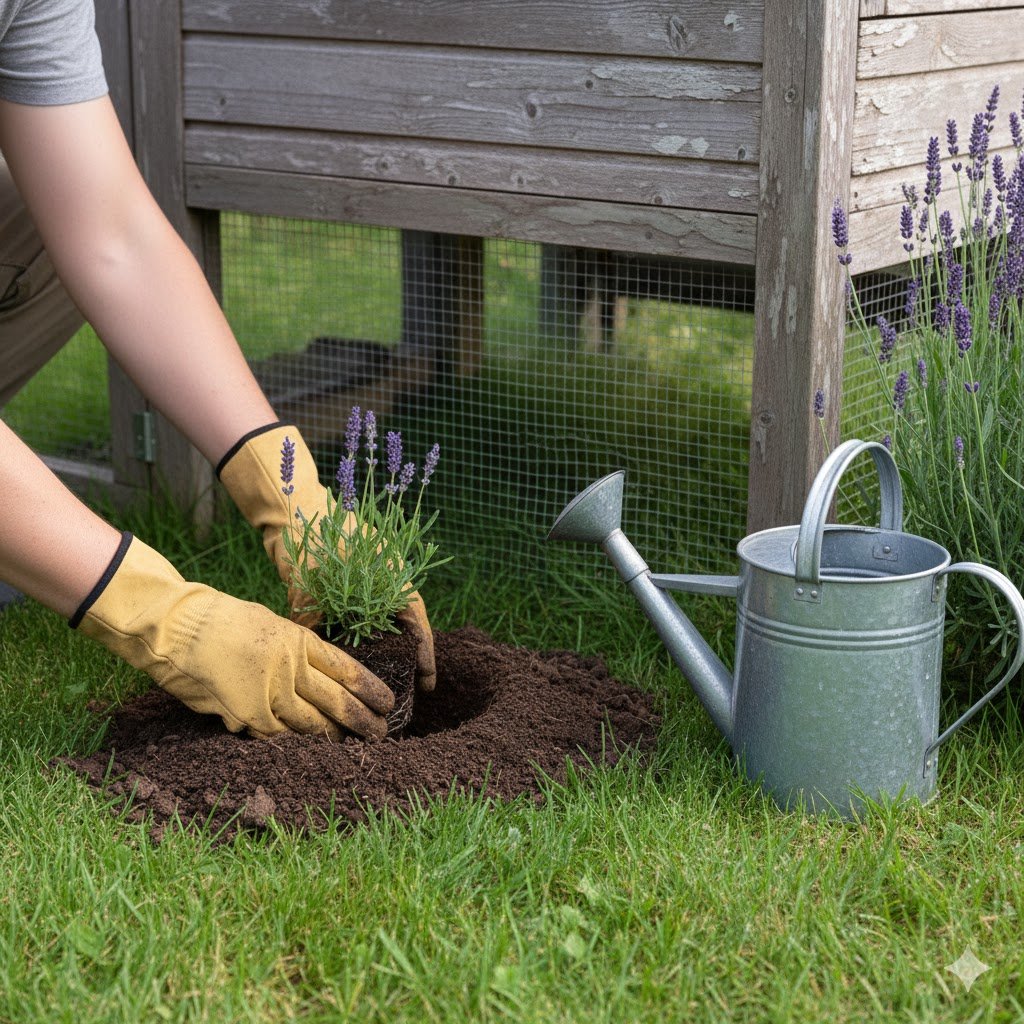
Ready to get planting for the 2025 season? Here’s how.
- Plan Your Space: Walk around your coop. Where are the high-traffic pest areas? (E.g., near the door, feed bin, or any known rat runs). Plan to plant your strongest-smelling plants (Mint, Lavender, Rosemary) there. Observe the sun—most of these herbs need at least 6 hours of sun to produce the strong-smelling oils you need.
- Leave a Gap! This is my most important tip. Do not plant right up against the coop wall. This traps moisture, which leads to wood rot, and gives pests a hidden, damp tunnel to live in. Leave a gap of at least 1-2 feet (about 30-60cm) between the plants and the coop wall.
- Prepare the Soil: Most UK garden soil is perfectly fine. If it’s very heavy clay (like mine!), mix in a bit of compost or grit to help with drainage, especially for plants like Lavender that hate wet roots. If your soil is awful, just use large pots.
- Planting Time: For perennial herbs like Lavender and Rosemary, it’s best to buy small “starter plants” from a garden centre in spring or summer. For Marigolds and Nasturtiums, growing from a packet of seeds after the last frost (around May) is super easy and cheap.
- A Friendly Reminder on Mint: Just as the table warning said, please plant your mint in a pot. A deep pot, or even an old bucket with holes drilled in the bottom, is perfect. Sink this into the ground if you want, but do not let those roots escape into your garden soil. I promise you, you’ll never get rid of it!
- Water and Maintain: Water them well to get them started. After that, these hardy plants are very low-maintenance. “Deadhead” (pinch off the dead flowers) your marigolds to keep them blooming all summer long.
You’ve got the plan, you know the plants, and you’re ready to plant. But you might still have a few lingering questions.
Your Top Questions Answered (FAQ)
Q: What three plants do rats really hate?
A: The top three are Mint (Peppermint), Lavender, and Sage. Their strong, pungent smells are overpowering for rodents and make your coop area very unattractive to them.
Q: Will these plants 100% rodent-proof my coop?
A: No. I want to be really honest here: no plant will make your coop 100% pest-proof. These plants help deter pests and are a vital part of a natural pest control strategy. You MUST still keep feed secure and the coop clean. They are a part of the solution, not the whole solution.
Q: My coop is in the shade. What chicken-safe plants for shade can I use?
A: That’s a great question, as most herbs love sun. For shady UK spots, try Mint (it’s not fussy at all), Garlic Chives, and some ferns (like the ‘Shuttlecock Fern’), which are non-toxic and love damp shade.
Q: What’s the best ground cover for a chicken run in the wet UK weather?
A: Mud is a huge problem. We have a full guide on ways to fix a muddy chicken run. The best solution is to lay down a 6-inch layer of hardwood wood chips. Softwood chips (like pine) can get mouldy and dusty. Hardwood chips break down slowly, drain well, and give the chickens something to scratch in. Sand is another good option for a well-drained area.
Q: Do plants really work against Red Mite?
A: They help. The strong smells of lavender, mint, and wormwood can help repel mites. Hanging dried bunches in the coop is a great preventative step. However, if you have a red mite infestation, plants will not cure it. You must do a deep clean and treat the coop with Diatomaceous Earth (DE) or another poultry-safe mite killer. The BHWT’s ultimate guide to red mite prevention has fantastic, in-depth advice on this.
Conclusion: A Healthier Coop for Your Hens
So there you have it. The best plants to grow around your coop to deter pests in the UK aren’t complicated or expensive. They are the hardworking, old-fashioned herbs and flowers our grandparents used.
By planting a simple border of Lavender, Mint, Sage, and Marigolds—and combining it with a good cleaning and feed-security plan—you can make your coop a much less friendly place for rats, mice, and mites, all while keeping it safe and natural for your hens.
From my own experience as a UK keeper, taking an hour this weekend to plant a few herbs around the coop is one of the best investments you can make. It’s a key part of good biosecurity, it looks pretty, and, as the BHWT always reminds us, a happy, stress-free hen is a healthy hen.
Your flock will thank you for it—and you’ll get the bonus of fresh herbs for your own kitchen.
What are your favourite safe flora for free-range hens? I’d love to hear what’s working in your garden.
This guide provides general advice based on personal experience and 2025 guidelines from sources like the BHWT and DEFRA. It is not a substitute for professional veterinary advice. Please consult a qualified professional for specific health issues or persistent pest infestations in your flock.

Oladepo Babatunde is the founder of ChickenStarter.com. He is a backyard chicken keeper and educator who specializes in helping beginners raise healthy flocks, particularly in warm climates. His expertise comes from years of hands-on experience building coops, treating common chicken ailments, and solving flock management issues. His own happy hens are a testament to his methods, laying 25-30 eggs weekly.
